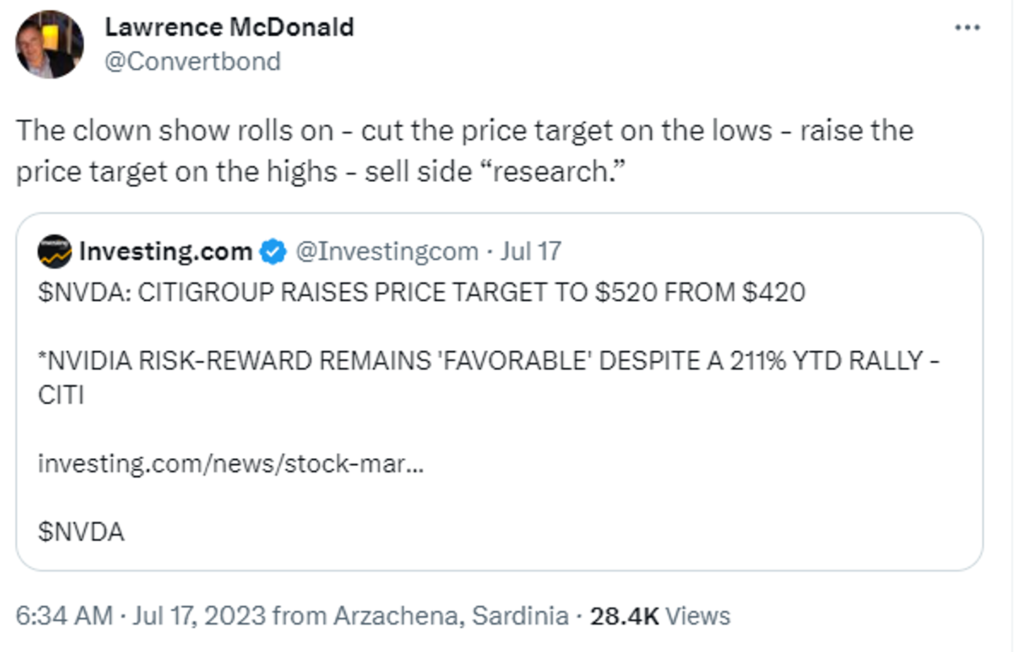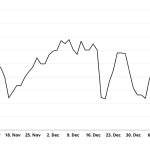
The average investor is chasing AI gains today … are AI stocks still a good buy at these valuations? … a roundtable discussion next week with our top analysts
The average investor loves to show up late to the party.
Actually, I’ll clarify…
He/she doesn’t “love” it, but it’s what happens year-after-year, decade-after-decade, resulting in underwhelming investment returns.
From a research piece titled “Who Chases Returns? – Retail vs. Institutional Investor Behavior”:
One thing that is clear from many studies is that retail investors chase performance.
“That is a fact,” said Diane Del Guercio of the University of Oregon in an interview. “It’s been documented over and over. It’s no longer really a question.”
Del Guercio is one of the few academic researchers who study determinants of investment flows. She has found when calculating performance that retail investors do not appear to factor in appropriate benchmarking and risking adjustments.
“Raw performance is virtually everything,” she said.
Moreover, retail investors are evaluating returns using shorter and shorter time frames with monthly (as opposed to just annual) performance becoming important.
So, where’s the performance (I’ll add “monthly performance”) been here in 2023?
You got – Artificial Intelligence (AI).
As we’ve covered here in the Digest many times, 2023 has been the year of AI. Though there’s growing evidence suggesting today’s bullishness is broadening, throughout the first half of the year, it was largely a black-and-white stock market…
You either owned AI stocks that exploded, or you held non-AI stocks that went nowhere.
The simplest illustration is a comparison of the Nasdaq 100 and the Dow Jones.
The seven largest holdings in the Nasdaq 100 are the so-called “Magnificent 7” stocks: Microsoft, Apple, Nvidia, Amazon, Tesla, Meta, and Alphabet. These are all viewed as top AI stocks.
In the first half of the year, the Nasdaq 100 climbed 39% while the Dow Jones added less than 4%.

But this broad index return is nothing compared to some individual AI stocks that have erupted this year.
There’s Schrodinger climbing 167%… Nvidia adding 189%… and Symbotic jumping 258%.
True to form, we now find that retail investors are chasing these AI returns
This headline from Yahoo! Finance from early June summarizes nicely:
“Stock market FOMO is back among average investors as AI and tech drive biggest stock market inflows in 3 months”
Here’s more from the article:
Individual investors may be stepping off the sidelines of the equity market as rallies in AI and technology stocks give rise to fear of missing out, Vanda Research said Thursday…
Vanda said average investors are beginning to chase the boom in tech stocks by widening their purchases across more AI-sensitive names including Palantir, Marvell and UiPath and beyond large-cap issues.
At the center of the AI investment frenzy is chipmaker Nvidia whose valuation this week pushed beyond $1 trillion. The stock has soared about 160% this year.
“AI and tech FOMO looks to be kicking in” following lackluster retail flows since the end of February, Marco Iachini, Vanda’s senior vice president of research, said in the note.
Retail investors have upped their bets in the weeks since this article published.
From Reuters:
[Retail investors] poured in $1.4 billion per day on average in U.S. equities in [June] closing in the all-time record of $1.5 billion a day in March, Vanda Research said…
Retail trading activity as a percentage of total market volume jumped to 21.9% as of July 5, highest since Jan. 24, and up sharply from 14% on May 31, according to J.P.Morgan data.
And all that FOMO-based buying pressure brings us to this week. Here’s Forbes from Tuesday:
Stock market indicators are back at extreme or practically extreme levels, suggesting that a topping process is underway.
These metrics tend to be confirmed by the “upgrades” to tech stocks now being announced by the major investment banking firms. The latest “even higher” price targets are a clue for those who study markets closely.
Such indicators often seem to go against the grain of the investment news headlines of the day and that’s what makes them valuable. They have a built-in contrary vibe when levels like this are reached, and the denial about their meaning is often heavy duty.
For brevity, I won’t include all the details of the Forbes article. But its broad tone suggests caution due to the explosion of retail bullishness.
Unfortunately, if/when some of these high-flying gains reverse, studies show that the average investor won’t sell, but instead, will just ride the stock lower.
Back to “Who Chases Returns? – Retail vs. Institutional Investor Behavior”:
[For retail investors], returns-chasing behavior is a one-way street. Said Jason Karceski, associate professor of finance, University of Florida, in an interview.
“Retail investors tend to let their underperforming investments sit.”
This behavior reflects a favorite investment joke from our CEO Brian Hunt…
What do you call a short-term trade gone wrong?
A long-term investment.
What this does, and does not, mean for AI opportunities today
Two things can be true at once…
One – AI is every bit the technological, cultural, and investment gamechanger it’s cracked up to be. It will create enormous wealth, and the financial opportunity before us today is very real.
Two – certain stocks/companies touting themselves as tomorrow’s AI winners – resulting in billions of retail investor dollars flooding their way today – won’t amount to much of anything.
This creates a challenge.
Given the runup in AI valuations this year… the snowballing FOMO that’s gripping the average investor… and the uncertainty about which AI companies will rise to the top in the coming years, how do you invest in AI today?
To be clear, not back in January or February – but today.
For example, is Nvidia still a good buy right now after its 189% surge this year?
It currently trades at 44 times sales – not earnings, mind you – but sales.
If you’re not sure how to contextualize this mindboggling price tag, the S&P currently trades at one of the highest price-to-sales ratios since 2000.
And exactly how high is it?
2.6.

And again, Nvidia trades at a price-to-sales ratio of 44…or 1,592% more expensive.
Now, sure, Nvidia is a top-tier chip company that’s at the cutting-edge of AI. It deserves a premium valuation. But 44-times sales?
Nvidia’s average price-to-sales ratio over the past five years is 18.31. Forgetting the S&P comparison, does Nvidia deserve this nearly 2.5X markup to its average, recent valuation?
But that’s really not the question either. The more important issue is “at this valuation, is the stock still a buy?”
It is if you’re listening to Wall Street.
Tying back to the Barron’s article above, NVDA is on the receiving end of new, higher price targets from analysts.
For example, Citi just boosted its estimate for Nvidia shares to $520 from $420. The Citi analyst behind the new target even suggested Nvidia could surge as high as $600.
On the other hand, Nvidia is not a buy if you listen to analyst Larry McDonald, editor of The Bear Traps Report. His take on Citi’s new price target for Nvidia was rather colorful: “the clown show rolls on.”
Here’s his full Tweet:

Given the challenge of investing in AI today versus at the beginning of the year, next Thursday at 7 PM ET, our three top analysts are sitting down for a roundtable discussion
Louis Navellier, Eric Fry, and Luke Lango are holding an emergency AI briefing called the AI Impact Event.
While they’re all bullish on AI overall, and have led their subscribers to double- and triple-digit gains in AI stocks this year, they also believe the next two months could bring some cratering stocks.
Here’s Louis with more:
2023 will go down as the year of artificial intelligence.
But for all the promises AI holds, there’s a destructive trend accelerating in the background…
Hundreds of stocks (potentially thousands worldwide) could soon see their share price drop 50% or more… (this is already happening) …
To be clear, I believe there’s a lot of money to be made as this new AI development unfolds. But the winners will come out of nowhere and fast…
To help you make sense of what’s about to happen as AI disrupts the entire stock market, I’ve joined forces with my colleagues and investing experts Eric Fry and Luke Lango.
Next Thursday, the three market experts will reveal their thoughts on the market, the evolution of AI, and where AI stocks go from here. To reserve your seat for this roundtable discussion, click here.
We’ll bring you more details on next Thursday’s AI Impact Event in the days to come, but if you’re wondering whether AI investments today remain a wise decision or are now just “chasing returns,” please mark your calendar to join us.
Have a good evening,
Jeff Remsburg





